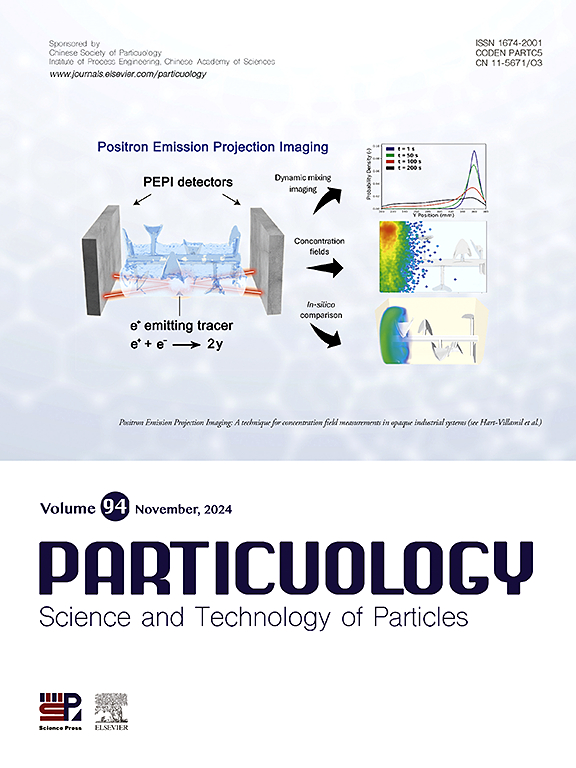Propagation characteristics and laws of RDX dust detonation
IF 4.1
2区 材料科学
Q2 ENGINEERING, CHEMICAL
引用次数: 0
Abstract
Compared with industrial dust, explosions involving hexogen (RDX) dust result in more severe consequences. Studying the explosion characteristics of RDX dust cloud in confined spaces is essential for improving industrial safety and military disaster prevention. In this study, a two-dimensional pipeline model was established using numerical simulation methods to investigate the effects of RDX concentration, ignition energy, pipeline length, and length-to-diameter ratio on the characteristics of RDX dust explosions. The results show that the essence of RDX dust explosions is a violent gas-phase chain exothermic reaction, with high-energy decomposition at its core. The explosion intensity increases non-linearly as ignition energy increases. For RDX concentrations of 100, 200, 300, and 400 g/m3, the time required to form a stable detonation decreases as the RDX dust concentration increases. When the ignition energy is in the range of 57.23 mJ to 10.1 J, changes in ignition energy have no significant impact on the energy released by the RDX explosion if the ignition energy is small. However, at high ignition energy, the explosive hazard of RDX increases significantly. As pipeline length increases, the stable detonation pressure and propagation velocity of the detonation wave essentially unchanged, but the rebound pressure on the pipeline wall gradually increases. In cases of high length-to-diameter ratios, a flame front reversal phenomenon occurs during the combustion process of RDX dust. In addition, a new dust rapid-filling method was developed using the C language, which enables rapid and uniform dust filling in combustion simulations.

RDX粉尘爆轰传播特性及规律
与工业粉尘相比,涉及己二异(RDX)粉尘的爆炸会导致更严重的后果。研究密闭空间中 RDX 粉尘云的爆炸特性对于提高工业安全和预防军事灾难至关重要。本研究采用数值模拟方法建立了二维管道模型,研究了 RDX 浓度、点火能量、管道长度和长径比对 RDX 粉尘爆炸特性的影响。结果表明,RDX 粉尘爆炸的本质是以高能分解为核心的剧烈气相链式放热反应。爆炸强度随着点火能量的增加而非线性增加。对于浓度为 100、200、300 和 400 g/m3 的 RDX,形成稳定爆炸所需的时间随着 RDX 粉尘浓度的增加而减少。当点火能量在 57.23 mJ 至 10.1 J 之间时,如果点火能量较小,点火能量的变化对 RDX 爆炸释放的能量没有明显影响。然而,当点火能量较高时,RDX 的爆炸危险性会显著增加。随着管道长度的增加,稳定爆轰压力和爆轰波的传播速度基本不变,但管道壁上的反弹压力逐渐增加。在长径比高的情况下,RDX 粉尘燃烧过程中会出现火焰前沿反转现象。此外,还利用 C 语言开发了一种新的粉尘快速填充方法,可在燃烧模拟中快速均匀地填充粉尘。
本文章由计算机程序翻译,如有差异,请以英文原文为准。
求助全文
约1分钟内获得全文
求助全文
来源期刊

Particuology
工程技术-材料科学:综合
CiteScore
6.70
自引率
2.90%
发文量
1730
审稿时长
32 days
期刊介绍:
The word ‘particuology’ was coined to parallel the discipline for the science and technology of particles.
Particuology is an interdisciplinary journal that publishes frontier research articles and critical reviews on the discovery, formulation and engineering of particulate materials, processes and systems. It especially welcomes contributions utilising advanced theoretical, modelling and measurement methods to enable the discovery and creation of new particulate materials, and the manufacturing of functional particulate-based products, such as sensors.
Papers are handled by Thematic Editors who oversee contributions from specific subject fields. These fields are classified into: Particle Synthesis and Modification; Particle Characterization and Measurement; Granular Systems and Bulk Solids Technology; Fluidization and Particle-Fluid Systems; Aerosols; and Applications of Particle Technology.
Key topics concerning the creation and processing of particulates include:
-Modelling and simulation of particle formation, collective behaviour of particles and systems for particle production over a broad spectrum of length scales
-Mining of experimental data for particle synthesis and surface properties to facilitate the creation of new materials and processes
-Particle design and preparation including controlled response and sensing functionalities in formation, delivery systems and biological systems, etc.
-Experimental and computational methods for visualization and analysis of particulate system.
These topics are broadly relevant to the production of materials, pharmaceuticals and food, and to the conversion of energy resources to fuels and protection of the environment.
 求助内容:
求助内容: 应助结果提醒方式:
应助结果提醒方式:


